For many, music is both a passion and a profession.
For those dedicated individuals, developing their musical skills to their highest potential is a constant undertaking.
A significant part of this endeavor involves familiarizing oneself with key aspects of music theory.
One such fundamental aspect is major chord progressions, often the framework upon which numerous popular songs and compositions are built.
Their effectiveness, versatility, and wide range of emotions they encompass make them an indispensable tool for any music professional.
Mastering these will significantly enhance your musical capabilities and enable you to produce more harmonious, captivating pieces.
Table of Contents
- Essential Major Chord Progressions
- I-IV-V (1-4-5)
- I–IV–vi–V (1–4–6–5)
- I-V-vi-IV (1-5-6-4)
- I-vi-IV-V (1-6-4-5)
- I-vi-ii-V (1-6-2-5)
- vi-IV-I-V (6-4-1-5)
- I-IV-ii-V (1-4-2-5)
- I-vi-V-IV (1-6-5-4)
- I-IV-I-V (1-4-1-5)
- vi–IV–I–V (6-4-1-5)
- I–V–IV–I (1–5–4–1)
- I–IV–VII–III (1–4–7–3)
- I–vi–IV–ii (1–6–4–2)
- I–vi–iii–V (1–6–3–5)
- I-III-IV-V (1-3-4-5)
- I–IV–V–vi (1–4–5–6)
- I-II-IV-V (1-2-4-5)
- The Bottom Line
Essential Major Chord Progressions
I-IV-V (1-4-5)
The backbone of countless hit melodies.
The I-IV-V progression, also known as the 1-4-5 progression, is an essential part of major chord progression that every musician should be familiar with. It is widely used in various music genres such as blues, rock, country and pop, due to its simplicity and harmonious sounds, forming backbone of countless songs and compositions.
- Difficulty: Easy
- Example: G – C – D (Key of G major)
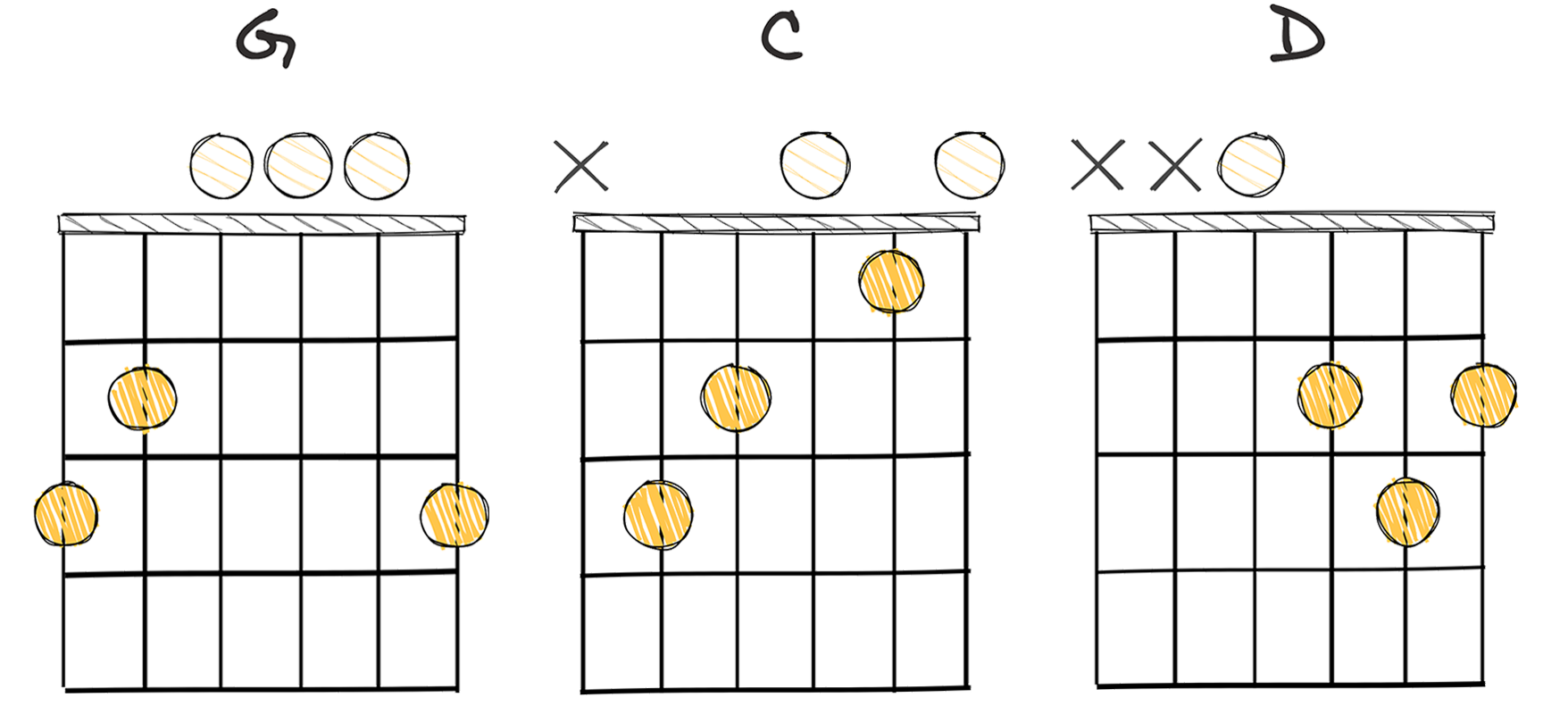
The I-IV-V chord progression is among the most fundamental and widely used sequences in all of music.
This progression is often referred to as the “three-chord trick.”
It is intriguing to note that this straightforward progression has its roots deeply ingrained in the history of music.
From classical composers to modern-day pop and rock musicians, countless pieces of music employ the simplicity and expressiveness of the I-IV-V progression.
With its humble beginnings in the works of classical giants like Bach and Mozart, the I-IV-V progression’s evolution over time reflects the narrative of music itself.
Its presence is evident throughout various genres, suggesting its universal appeal and effectiveness.
As a musician, understanding this progression is crucial.
Combining only three chords creates a fuller and complete sound, making it a major player in pushing musical narratives forward.
Mastering the I-IV-V chord progression can open up a world of possibilities, allowing musicians to craft melodious tunes with minimal effort!
This statement is apparent when we glance at some of the memorable songs constructed around this progression.
Its simplicity makes it easy to play, which can be a stepping stone for beginners to dive into the world of composing and performance.
The I-IV-V progression is an absolute staple in country, blues, and rock genres.
However, its flexibility and adaptability make it fit in any music style.
Additionally, it’s a fantastic progression for budding songwriters to experiment with and compose their original tracks.
Using just these three chords, I-IV-V, in different rhythmic and stylistic variations, musicians can create a wide variety of harmonic backgrounds.
This adaptability is what makes this progression a musician’s best friend.
It is essential to note that the broad appeal of the I-IV-V progression lies in its perfect balance between repetition and variation.
This balance makes it a robust framework for creating memorable hooks and melodies.
Emphasizing the relationship between these three chords can help develop a deeper understanding of chord progression, leading to better composition and improvisation skills.
As a musician looking to create compelling and engaging music, having an excellent command over the I-IV-V progression is almost non-optional.
I–IV–vi–V (1–4–6–5)
A quintessential cornerstone of majestic musical harmony.
The I–IV–vi–V (1-4-6-5) progression in the key of F Major results in the chords F Major, Bb Major, D Minor, and C Major. This chord sequence offers a satisfying resolution, while the movement from the subdominant (IV) to the relative minor (vi) adds emotional depth.
- Difficulty: Intermediate
- Example: F – Bb – Dm – C (Key of F major)
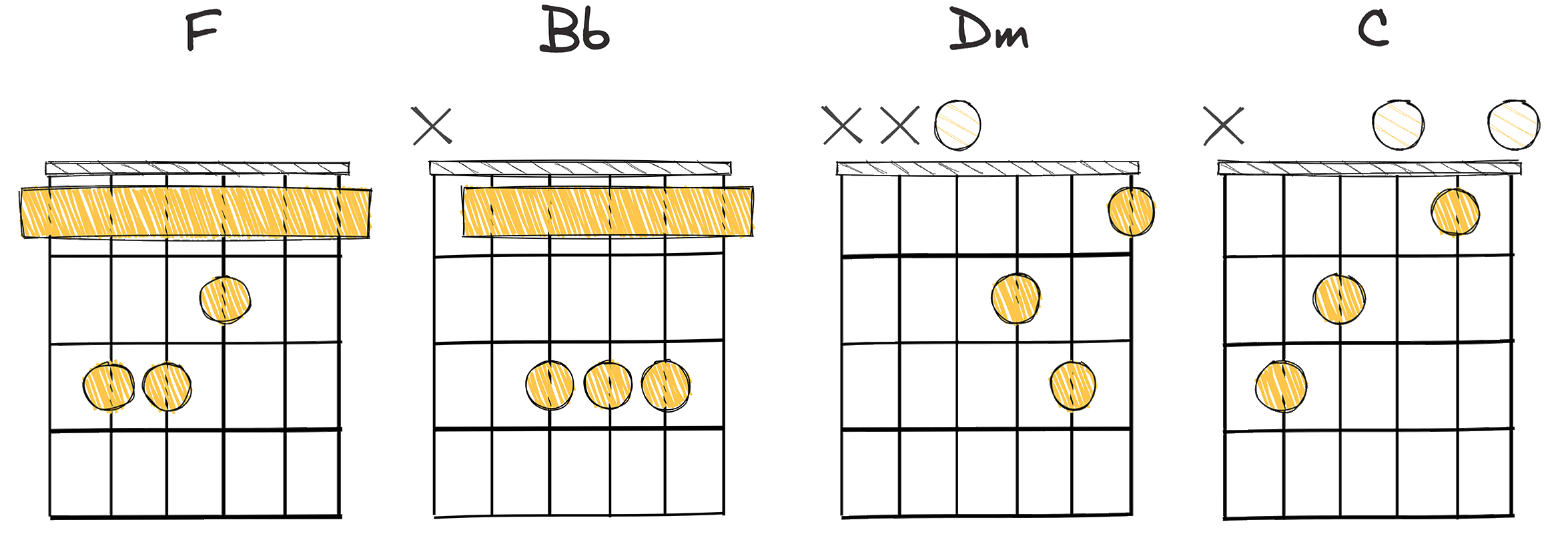
The I–IV–vi–V (1-4-6-5) chord progression in the key of F major provides a harmonious flow of chords that are pleasing to the ear.
Starting on the tonic, F major, sets the tonal center of the progression, grounding the listener in the home key.
Next, moving to Bb major, the IV chord, brings about a sense of departure or shift.
This subdominant chord is a step away from the home key but is closely related, sharing two of the three notes with the tonic chord.
Then, the progression moves to D minor, the vi chord.
As the relative minor of the key, this chord adds an element of melancholy or emotional complexity.
Following the vi chord, the progression shifts to the dominant, C major, or the V chord.
The dominant chord has a strong pull towards the tonic, creating tension that is then resolved when the progression loops back to the F major.
Finally, cycling through this progression can create a sense of narrative in the music, as the chords journey away from and return to the home key, carrying the listener along with them.
I-V-vi-IV (1-5-6-4)
Versatile, universally engaging tonality.
The I-V-vi-IV chord progression is one of the most popular sequences in music, notable for its appealing resolution and emotional impact. Found in many genres from pop to classical, it’s known for its versatility and simple, catchy nature, often used as a foundation for memorable melodies.
- Difficulty: Intermediate
- Example: C – G – Am – F (Key of C major)
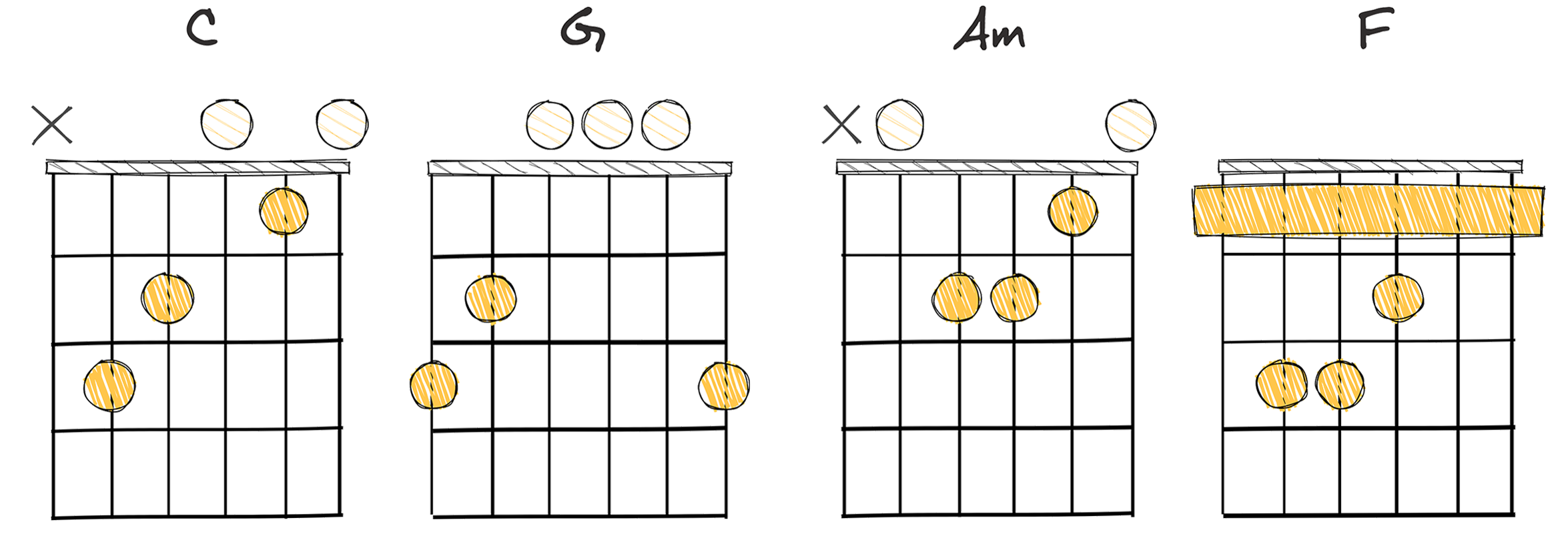
The 1-5-6-4 chord progression, otherwise denoted as the I-V-vi-IV progression, is one of the pillar chord progressions in popular music.
Chord progressions are an essential part of music composition, and the 1-5-6-4 progression, in particular, has firmly held its position as a staple of memorable and engaging songs.
There is an unmistakable characteristic to the 1-5-6-4 progression, which resonates with listeners, giving it a long and rich history of usage in illustrious music pieces.
One key factor that has contributed to the wide usage of this progression is that it is quite easy to play, making it a first choice for beginners and professionals alike.
The simplicity of the chords in this progression does not limit its capacity for nuance and variation.
Therefore, when applied in varied contexts and musical styles, this progression can yield diverse effects, evoking different emotions and creating different soundscapes.
This flexibility has ensured its consistent presence in tunes across a wide spectrum of music genres, including rock, pop, country, and blues.
Mastery over this progression is essential for every musician because it is foundational to music theory and practice.
Consequently, practicing and mastering this simple yet powerful chord progression is crucial for musicians who aim to expand their repertoire and create compelling music pieces.
Armed with the I-V-vi-IV progression, musicians can explore a vast library of potential musical ideas and bring their own unique expression to life.
I-vi-IV-V (1-6-4-5)
A timeless foundational chord progression favored by pop musicians.
The I-vi-IV-V progression, or the 1-6-4-5 progression, is a popular and fundamental chord progression used in many genres of music, particularly pop and rock. It’s known for its deep emotional resonance and simple, memorable harmony, providing a solid foundation for many catchy and globally renowned songs.
- Difficulty: Easy
- Example: G – Em – C – D (Key of G major)
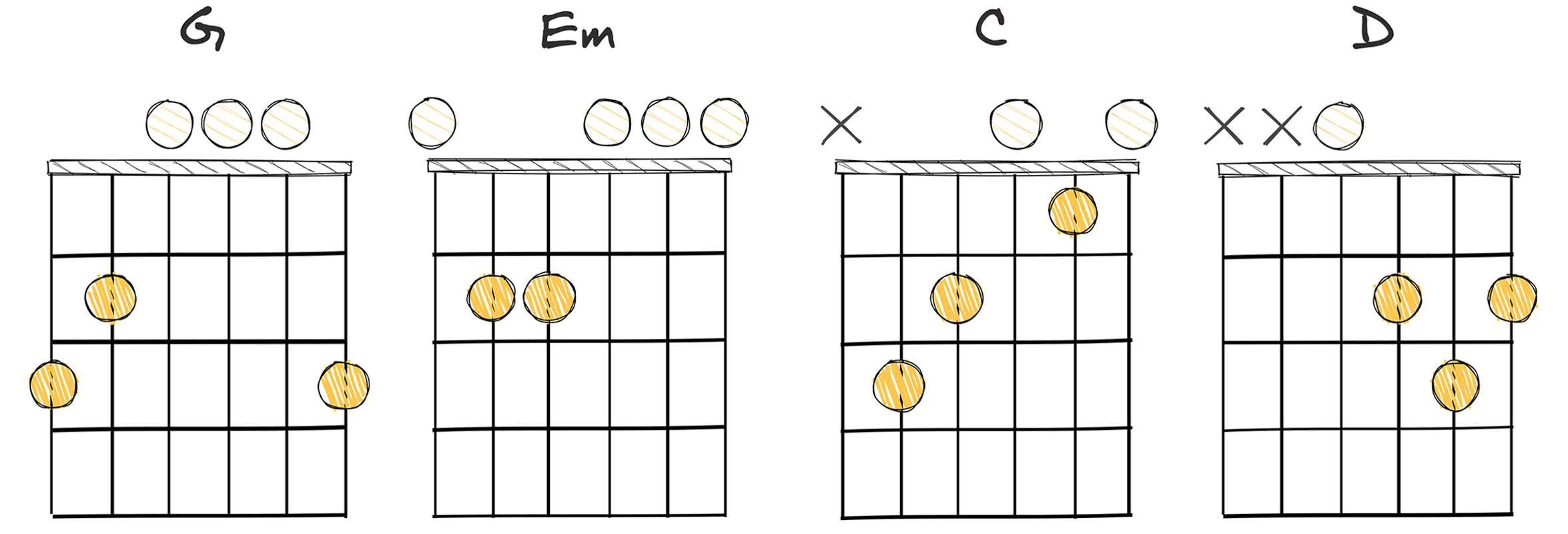
The I-vi-IV-V (1-6-4-5) chord progression is among the list of basic chord progressions that every musician, especially those starting out, should aim to master.
This progression is common in popular music and it’s recognized for its simplicity and pleasing sound.
Interestingly, with its history tracing back to the heart of classical music, the I-vi-IV-V progression has been an essential tool for countless composers and songwriters.
Notably, the conventionality of this progression does not take away from its ability to create a variety of moods for any piece.
Instead, it adds depth and structure while leaving enough room for creativity.
Chord progressions like the I-vi-IV-V offer a simple yet effective structure for songwriters and composers to build their melodies.
Whether in a slow ballad or an upbeat pop tune, the I-vi-IV-V progression maintains a strong harmonic base while offering a harmonic richness.
This quality of the I-vi-IV-V progression facilitates musical expression in different genres.
Moreover, its simplicity eases its application, allowing musicians to focus more on the melodies and lyrics of the song, which are often the most effective channels of emotion.
Essentially, the I-vi-IV-V progression is easy to play, allowing musicians, especially beginners, to quickly pick up and create their own tunes.
This seemingly simple progression indeed wields great power in the hands of a thoughtful musician.
Indeed, the I-vi-IV-V progression is not just the core of many iconic songs, it’s also a vital stepping stone for budding musicians to explore their creative potential.
I-vi-ii-V (1-6-2-5)
A quintessential progression, oozing versatility across all musical genres.
The I-vi-ii-V chord progression, also known as the 1-6-2-5 progression, is a fundamental sequence in music that offers a harmonious flow. It’s a staple in various genres such as jazz and pop, known for creating a circular motion to the harmony, introducing tension, and providing an excellent foundation for melodies.
- Difficulty: Easy
- Example: C – Am – Dm – G (Key of C major)
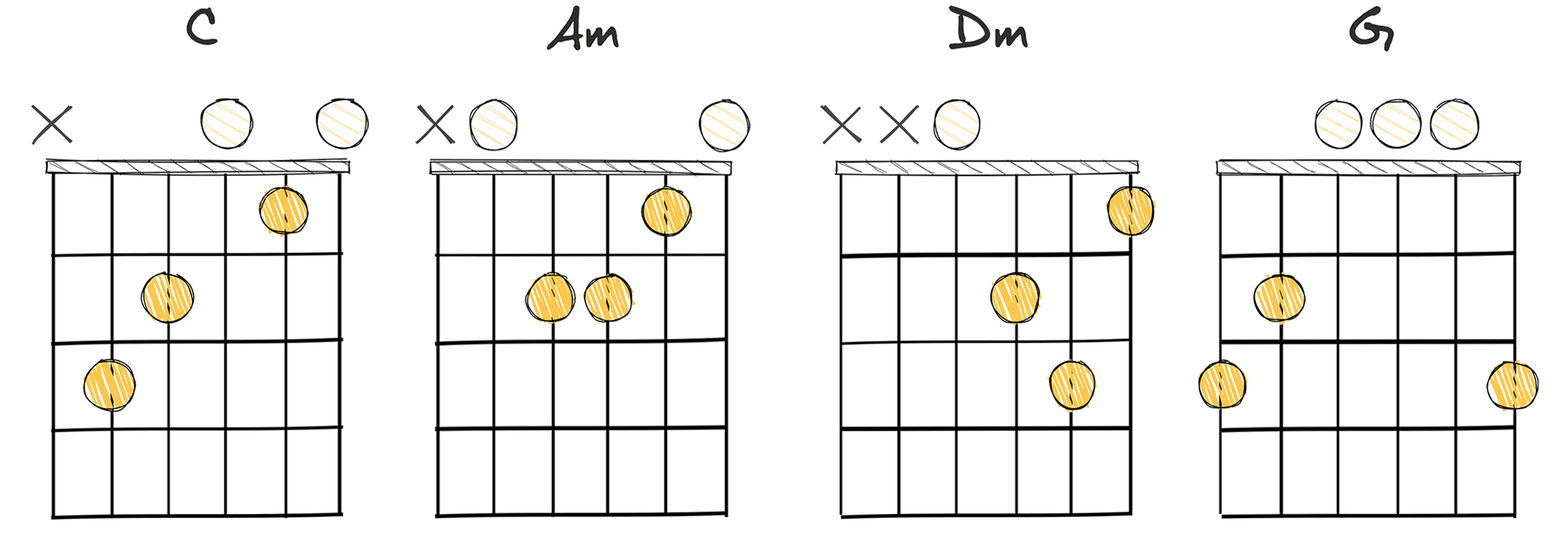
The chord progression I-vi-ii-V (1-6-2-5) is a fundamental progression that every musician should strive to master.
Popular in both jazz and classical music, this progression has a long history of being used in a variety of musical settings.
The power of this progression lies in its simplicity and familiarity.
Because of its frequent usage in popular music, listeners often recognize and anticipate its progression, creating a sense of comfort and satisfaction.
Furthermore, it’s easy to play which is another attribute that makes it desirable for many musicians, both experienced and novice alike.
When considering the harmonic movement, the progression particularly shows its strength.
It creates a compelling arc and demands resolution in a pleasing and familiar way.
Yet, despite its predictability, it allows for plenty of variation and improvisation.
It’s common to add extensions, alterations, or substitute chords to enhance the harmonic richness of the progression.
These variations can provide unexpected color and tension-release patterns within the confines of the chord progression structure, leading to a rewarding listening and playing experience.
So, whether you’re a jazz pianist, a classical guitarist, or a budding songwriter, making time to master this progression will undoubtedly pay dividends in your musical journey.
Remember, the chord progression I-vi-ii-V is only a starting point.
vi-IV-I-V (6-4-1-5)
This popular progression lays the melodic foundation for countless songs.
A staple in many genres of music, renowned for its emotional pull and versatility. It creates a poignant sound due to each chord’s transition, making it a highly popular choice among songwriters and a fundamental progression for musicians to master.
- Difficulty: Intermediate
- Example: Am – F – C – G (Key of C major)
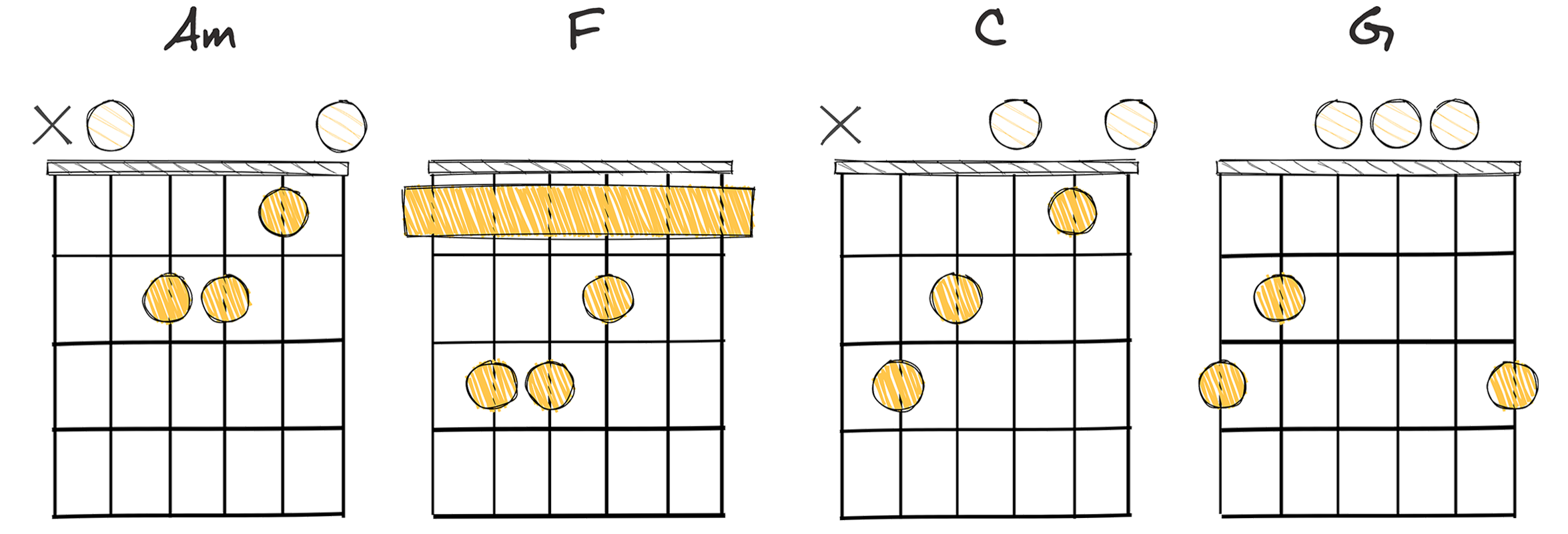
The vi-IV-I-V (6-4-1-5) chord progression is one of the fundamental pillars in the world of music.
From classical compositions to modern pop songs, this sequence of chords prevails in countless music pieces and genres.
Eminent in its simple beauty and melodic potential, this chord progression tends to play a crucial role in setting the emotional tone of a song.
This fact has made it a perennial favorite among composers and songwriters of diverse musical styles.
Throughout its rich history, this harmonic progression has indeed proven its versatility.
This is confirmed by numerous songs spanning various eras and genres, and all have the shared harmonic backbone of the vi-IV-I-V progression.
The vi-IV-I-V progression’s history is rich, with its roots anchored deeply in classical music, where it served as the foundation for many compositions.
It was not too long before this progression found its way into modern genres like pop, rock, and jazz, carrying its musical charm into the 21st century.
One of the main reasons that this sequence is so prevalent is that it is easy to play, especially on guitar and piano.
Its simplicity makes it accessible to musicians of all skill levels, opening the door for beginners to achieve a pleasant and satisfying sound.
Whether you’re composing a new piece or jamming with some of your favorite tunes, the vi-IV-I-V progression is an indispensable tool in your musical arsenal.
I-IV-ii-V (1-4-2-5)
A heart of countless songs, the I-IV-ii-V progression sparks creativity.
The I-IV-ii-V progression is a classic and fundamental chord sequence in the world of music that is commonly used across various genres, from pop to jazz. This progression is renowned for providing a harmonically rich and pleasing sound, which acts as a solid foundation for songwriting and improvisation.
- Difficulty: Intermediate
- Example: G – C – Am – D (Key of G major)
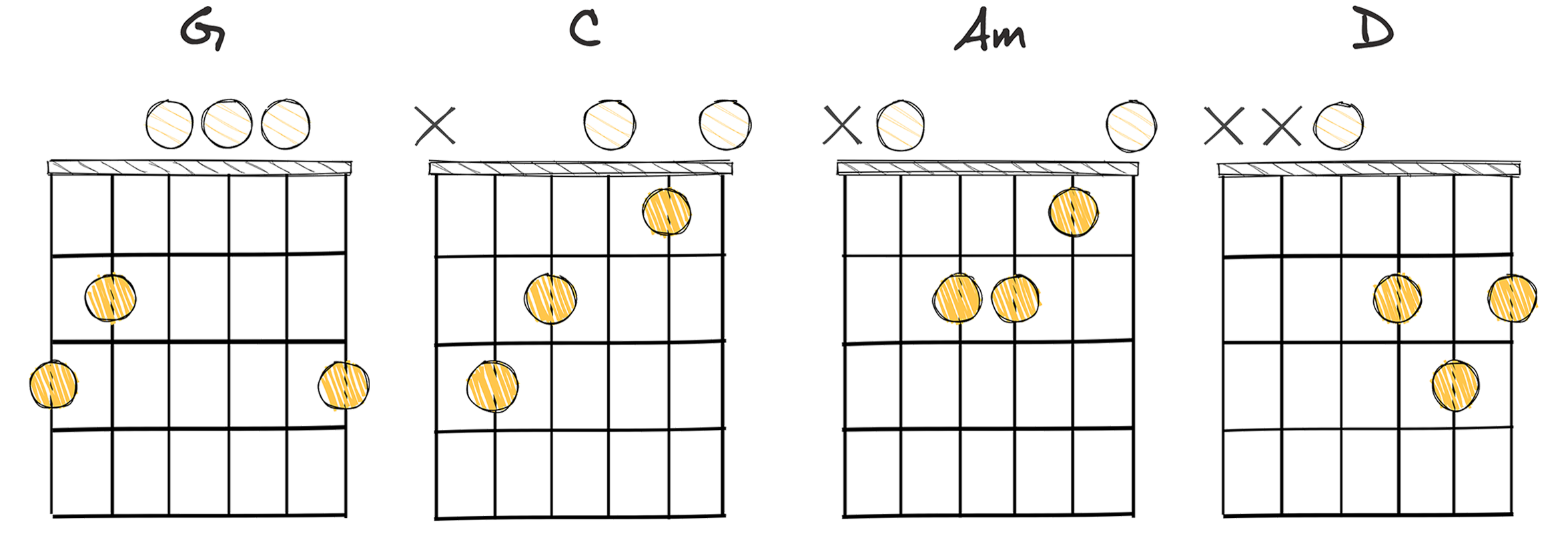
The I-IV-ii-V (1-4-2-5) chord progression is an essential major chord sequence that every musician should master.
This progression is intermediate, which means that it may require a bit more practice compared to some other chord sequences.
The reason for this is that it involves some uncommon transitions, which are not often used in many of the major hits, but are still essential for developing a comprehensive understanding of harmony and chord progressions.
Understanding and mastering this progression can open doors to a wide array of music genres and styles.
Knowing the I-IV-ii-V progression can lend any musician a new perspective to both the composition and interpretation of songs.
This chord progression has a rich history in music, finding its roots in jazz, classical, and even rock music.
It has been employed by songwriters and musicians across different eras, proving its enduring significance and versatility.
In the key of G major, the I-IV-ii-V chord progression would be represented as G – C – Am – D.
Mastering the I-IV-ii-V progression not only enhances your music interpretation skills but also deepens your understanding of chord progressions.
This invaluable knowledge is a testament to the chord progression’s influence and indispensability in the music world.
I-vi-V-IV (1-6-5-4)
A versatile, melancholic chord progression popular in mainstream pop music.
The I-vi-V-IV chord progression is a fundamental sequence in music that is especially prevalent in pop and rock genres, renowned for its pleasing sense of resolve and cyclical motion. This progression offers a seamless transition between chords, often serving as the backbone of a song’s structure, thereby making it a vital progression every musician should master.
- Difficulty: Intermediate
- Example: C – Am – G – F (Key of C major)
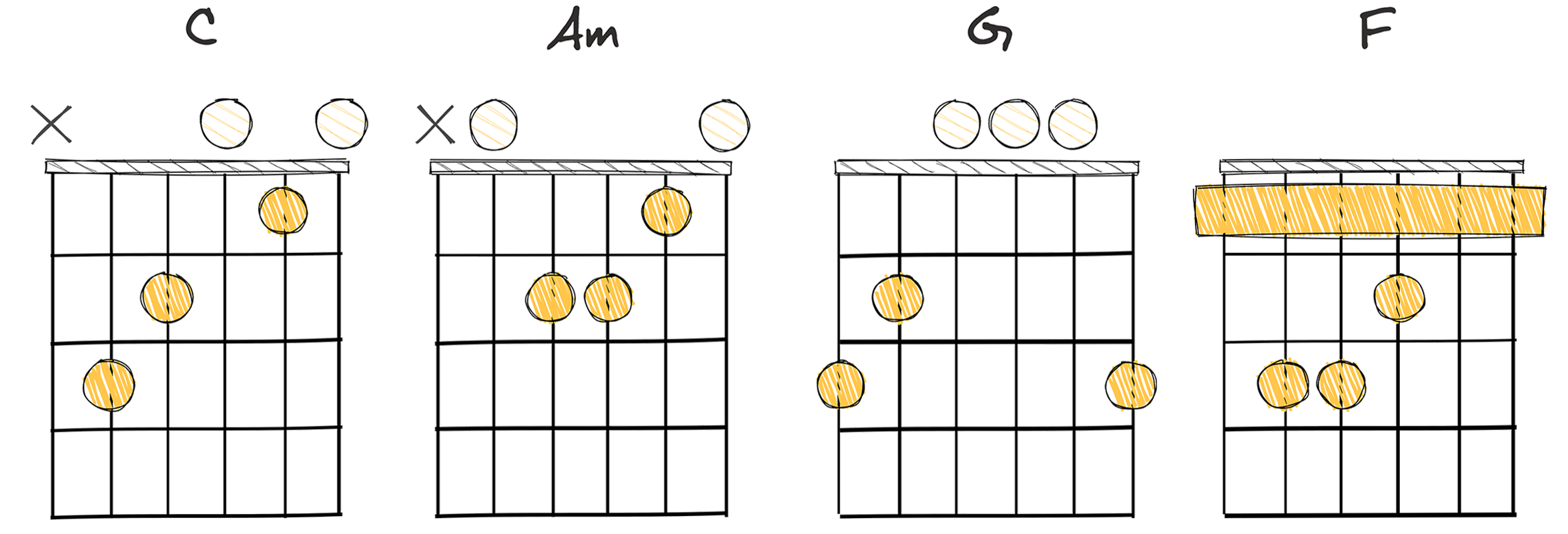
When exploring the realm of music theory and practice, there is a key area that never fails to remain relevant: chord progressions.
More specifically, the I-vi-V-IV (1-6-5-4) chord progression is a crucial piece of knowledge that every aspiring and professional musician should master.
This particular sequence of chords, commonly known as the 1-6-5-4 progression, has been heavily used in various music genres due to its pleasing resonation and seamless transition capabilities between chords.
Historically, the I-vi-V-IV progression has roots dating back to the classical music era, gradually gaining popularity and now being an integral part of modern pop and rock compositions.
Artists and composers utilize this chord progression for its universally appealing sound and the emotional resonance it instills in music listeners.
Supporting this statement, the beauty of this chord progression lies in its balanced combination of tension and release, as well as its potential to instill a wide range of emotions within the listener.
Furthermore, it provides flexibility for modification, which caters to the artist’s unique creative vision.
The I-vi-V-IV progression is quite easy to play on various instruments, which adds to its accessibility and popularity among musicians of all levels.
Such progression is not overly complex or demanding, thus allowing the player to focus more on other aspects of music such as dynamics, rhythm, and overall expressiveness.
Aforementioned, every musician—whether professional or amateur, songwriter or instrumentalist—should endeavor to learn and master the I-vi-V-IV chord progression.
Mastery of this progression not only broadens a musician’s musical understanding but also serves as a powerful tool for captivating and engaging an audience.
Doing so encourages the artist to continue exploring other chord progressions and techniques, further expanding their musical skills and knowledge.
Remember that every chord, note, and rhythm holds the potential to convey powerful emotions to the listener, and mastering various chord progressions such as the I-vi-V-IV can help to actualise this potential.
The I-vi-V-IV progression’s simplicity, versatility, and powerful emotional conveyance make it an essential part of any musician’s toolkit.
I-IV-I-V (1-4-1-5)
This progression, weaving stability and tension, is a music bedrock.
This I-IV-I-V chord progression, also known as the “Circle Progression”, is a simple yet highly effective sequence found in countless hit songs across multiple genres. Its structure creates a sense of tension and release, providing a solid foundation, driving the rhythm and guiding listeners through the emotional journey of the music.
- Difficulty: Easy
- Example: G – C – G – D (Key of G major)
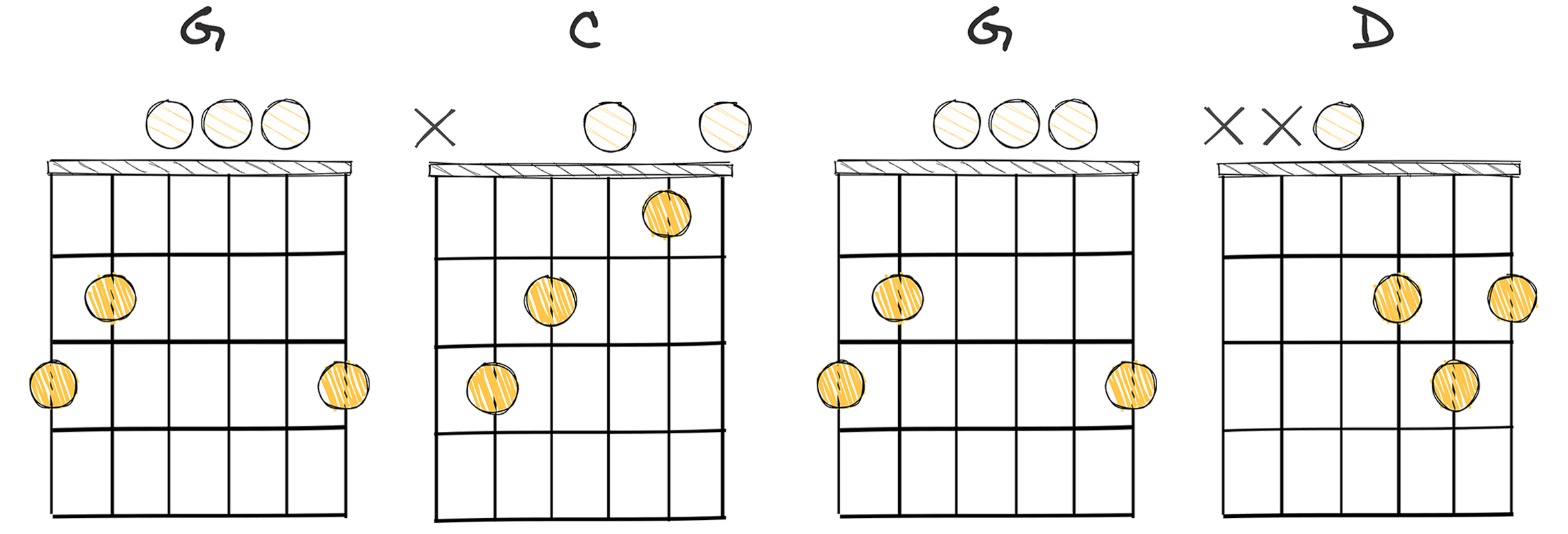
The I-IV-I-V (4-1-4-5) chord progression plays a pivotal role in the fabric of modern day music.
Historically, this progression has been used extensively within the Pop, Rock, and Roll genres.
This has not changed much over the years, proving the universality and timelessness of this chord progression.
This progression is popular not only because of its appealing sound but also because of how easy it is to play.
This makes it a perfect starting point for many beginner musicians.
The beauty of the I-IV-I-V progression lies in its ability to create a feeling of melancholic resolve with the transition from the IV to I, followed by the unanswered tension from the V to I.
The simplicity of the transitions in the I-IV-I-V progression and the tonal variety it offers make it a favorite among many musicians.
This quote above suggests that not only is this chord progression simple and easy to grasp for beginner musicians, it also offers a wide tonal variety that adds to the appeal for more experienced musicians.
Adding to this, the progression provides a “complete” feeling, delivering a satisfactory transition and resolution thereby enhancing ones musical piece immeasurably.
In addition to being a satisfying chord progression, I-IV-I-V can, with its progressions and transitions, unlock a whole new world of musical possibilities for artists.
So, whether you’re a beginner looking to grasp the basics or an expert looking to experiment, you really can’t go wrong with starting to learn and master the I-IV-I-V chord progression.
vi–IV–I–V (6-4-1-5)
Classic jazz progression offering endless possibilities for melodic improvisation.
The vi–IV–I–V chord progression, also known as 6-3-1-5, is a fundamental sequence in music theory that lends a sense of resolution and completion to a musical phrase or piece. It is favored in a variety of music genres, particularly in jazz, due to its harmonious and satisfying sound that helps to establish the key of a song.
- Difficulty: Easy
- Example: Bm – G – D – A (Key of D major)
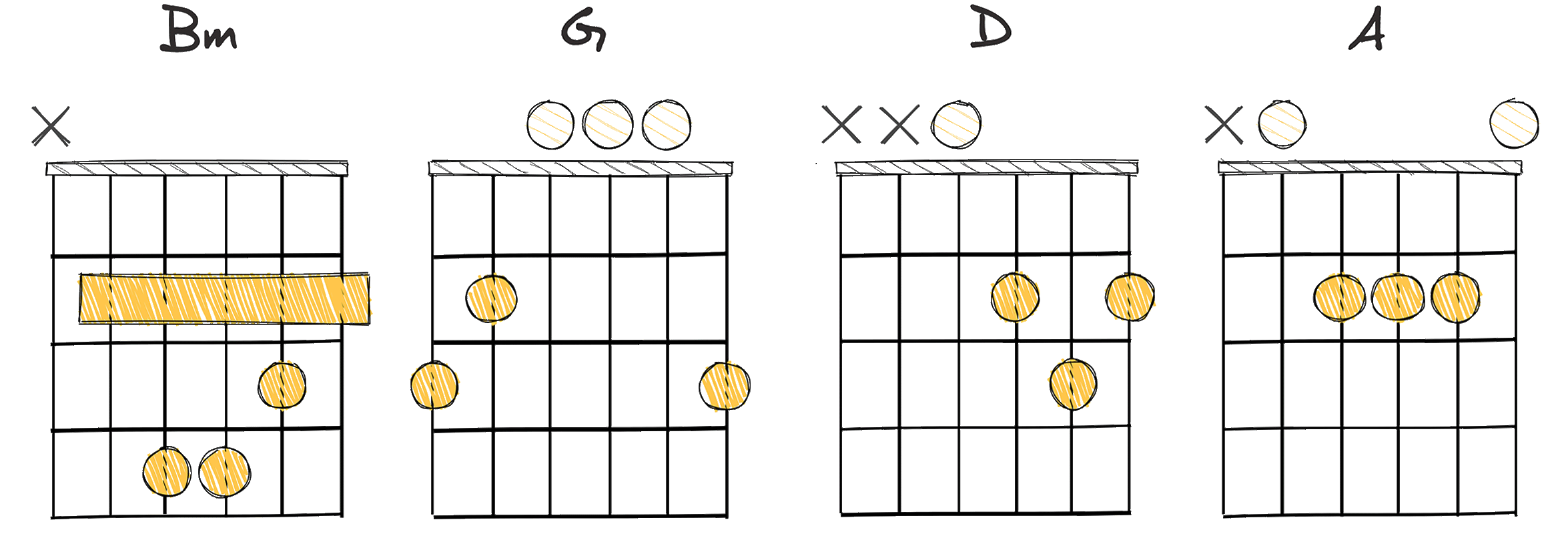
The vi–IV–I–V (6-4-1-5) chord progression is a highly popular progression found extensively in pop, rock, and country music.
This progression creates a cyclical pattern that starts on the vi chord, often referred to as the relative minor in a major key, bringing an initial sense of melancholy or depth to the music.
From the vi chord, it moves to the IV chord, a change which provides a shift in mood.
The IV chord, known as the subdominant, is a close neighbor to the tonic and often gives a sense of anticipation or departure from the tonic.
The progression then lands on the I chord, the tonal center of the piece, often giving a feeling of resolution or return.
The I chord, also known as the tonic, provides a sense of home base in the context of the key.
Finally, the progression ends on the V chord, also known as the dominant, which is characterized by its strong tension and desire to resolve back to the tonic, effectively creating an urge to repeat the cycle.
This V chord adds a feeling of expectancy and momentum, leading the listener back to the beginning of the progression.
In essence, the vi–IV–I–V progression allows for a continuous circle of tension and release, propelling the music forward and creating an engaging emotional journey for the listener.
The repetitive nature of this progression also makes it an excellent choice for catchy hooks and memorable melodies.
I–V–IV–I (1–5–4–1)
A versatile progression serving as foundation for numerous pop anthems.
The I–V–IV–I chord progression is a mainstay in the world of music, often found in various genres due to its balance, resolution, and versatility. This sequence provides a satisfying sense of closure in the first half but then intriguingly reopens the musical statement with the second V (5), making it an essential progression that every musician should learn to master.
- Difficulty: Easy
- Example: G – D – C – G (Key of G major)
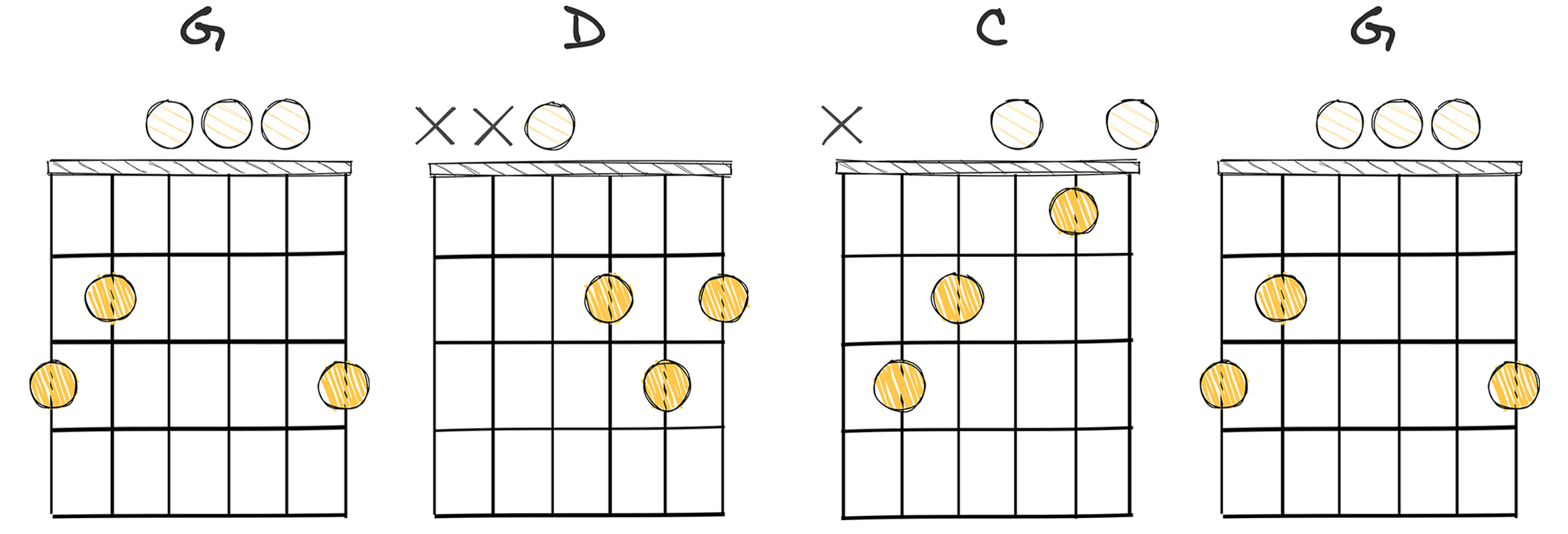
The I–V–IV–I (5-1-4-5) chord progression is among the most fundamental structures, serving as a valuable tool in the repertoire of many musicians.
Tracing back its roots, this iconic chord pattern has been seen in a myriad of genres from the golden eras of blues and jazz, to the birth of rock and roll, up to the contemporary scene of pop and indie music.
As its prevailing presence illustrates, the I–V–IV–I progression is not genre-specific, but rather, an essential element that knows no bounds.
Its enduring popularity can be attributed to its simplicity and versatility.
This progression happens to be incredibly easy to play, which makes it a favourite among both novice and seasoned musicians.
For beginners, mastering this chord progression is a vital stepping stone toward understanding the musical structure and honing the intricacies of playing.
For the veterans, its timeless charm opens doors for creative exploration through different voicings, rhythms, and complex harmonic substitutions.
The I–V–IV–I chord progression not only serves as a reliable touchstone for beginners learning their way around their instrument but also as a powerful device in the arrangement arsenal of skilled musicians.
It encapsulates the essence of harmony, embodying the beauty and complexity that can be achieved through the intelligent manipulation of just a few simple chords.
Indeed, despite its inherent simplicity, the I–V–IV–I progression opens up a whole world of musical possibilities, effectively contributing to the diverse musical landscape we enjoy today.
I–IV–VII–III (1–4–7–3)
This iconic progression forms the backbone of countless jazz standards.
The I–IV–VII–III is a core progression in music theory, commonly used in a plethora of musical genres due to its smooth, classic transition and resolution. This cycle of chords has a characteristic of implying a harmonic motion and producing a particular cadence that musicians often employ to create interesting melodic lines.
- Difficulty: Intermediate
- Example: E – A – D – G (Key of E major)
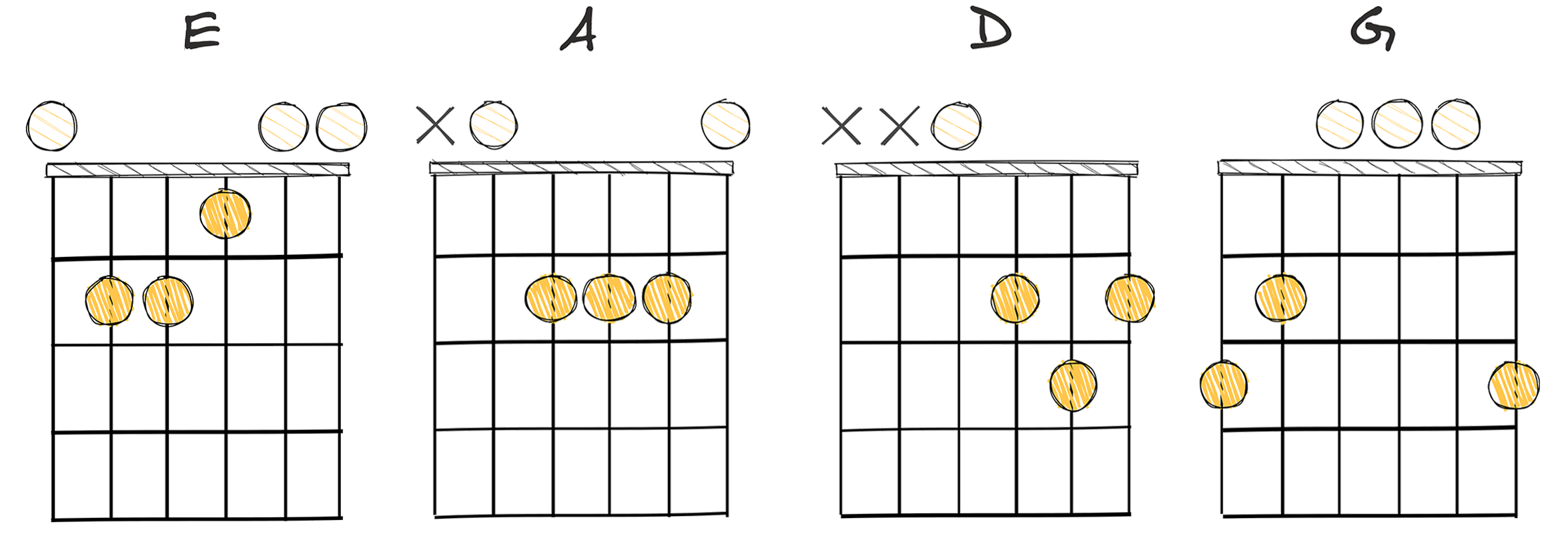
When it comes to mastering essential major chord progressions as a musician, it’s important to understand the complexities of different sequences and their significance in music theory.
The I–IV–VII–III progression carves out its own unique place.
While not as evidently present in popular music as the ubiquitous 2-5-1 or 1-4-5, this one holds a distinct charm for many musicians and music connoisseurs.
The progression adds an extra layer of melodic and harmonic depth to a tune.
Historically, the 1-4-7-3 chord progression has its roots embedded in jazz music.
This progression developed as a variation of the backstage cycle and the II-V-I progression, and was also referred to as the “turnaround progression”.
This chord progression’s unique melodic contour comes from the use of minor chords that add a bit of tension to the music before being resolved, making it more intriguing for both the musician and the listener.
These chords create a pattern that provides a sense of resolution and completion, making the song sound more pleasant to our ears.
More than just a simple chord sequence, the I–IV–VII–III is a guide through the soundscape of a song, a roadmap to its harmonic structure.
The complexity of these chords contributes to the sense of yearning in the music.
Moreover, the progression is intermediate to play, making it a valuable addition to any musician’s repertoire who wishes to explore jazz and more advanced music theory without being too overwhelming.
The technical aspect of this progression involves a bit of chord shape alternation due to the introduction of minor chords.
In fact, alternating between the minor chords can be seen as a smooth way to develop the finger dexterity and strength necessary for more complex chords.
This chord progression, while a bit challenging, offers both practice and insight into the intricate world of music theory.
Understanding and mastering the I–IV–VII–III chord progression can open the door to more complex compositions and a more nuanced understanding of harmonic functionality in music.
It’s a stepping stone on a musician’s journey towards richness and depth in their musical expressions.
Therefore, making an effort to study and practice this chord sequence can enrich your musical knowledge and skill, and prepare you to explore more sophisticated compositions in your future musical journey.
I–vi–IV–ii (1–6–4–2)
A versatile progression, adding depth and emotion to any composition.
This I–vi–IV–ii progression is a staple in many genres of music, providing a pleasing harmony that is both emotionally evocative and easy to follow. It offers a mild touch of tension via the VI chord and resolves it by seamlessly transitioning to the IV and II chords, leaving the listener satisfied yet eager for more.
- Difficulty: Intermediate
- Example: G – Em – C – Am (Key of G major)
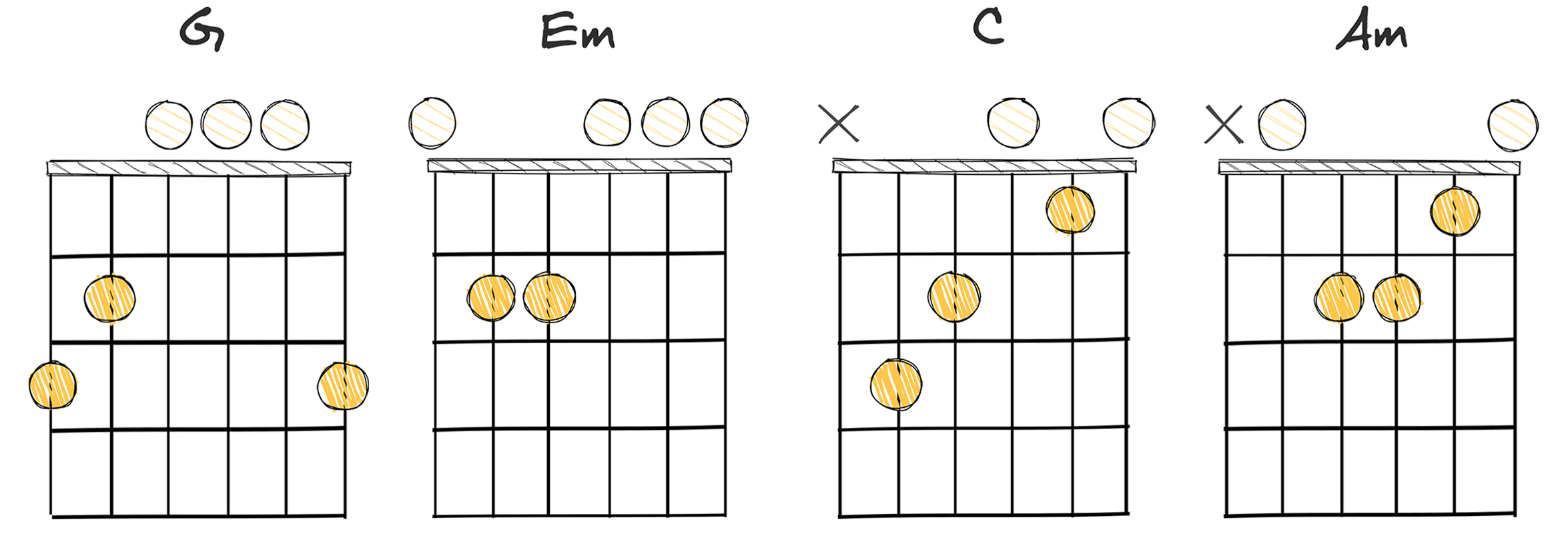
Chord progression is one of the building blocks in music composition, and I–vi–IV–ii is an incredibly versatile one.
This chord progression is often seen as intermediate in terms of difficulty to play, making it a common choice for many upcoming musicians.
The I–vi–IV–ii progression holds a significant place in music history.
It’s been a part of countless melodies and harmonies since the Baroque era, giving life to various iconic pieces of music.
The progression has evolved alongside music, finding its place in today’s contemporary scene too.
Learning and mastering such chord progressions is highly beneficial, even to intermediate musicians.
It becomes a stepping stone for them to experiment further with their compositions while building a solid foundation.
So it can indeed be said that the I–vi–IV–ii progression is both a challenge and an opportunity for musicians of all levels.
It assists them to dig deeper into their musical ability creating, creating music that is truly mesmerizing.
I–vi–iii–V (1–6–3–5)
A staple progression, offering a tranquil transition between major chords.
The I–vi–iii–V progression is an integral part of major chord progression that musicians should master. This composition provides a harmonically rich and balanced sound, often used in a variety of popular and classical music genres due to its musical aesthetics.
- Difficulty: Easy
- Example: D – Bm – F#m – A (Key of D major)
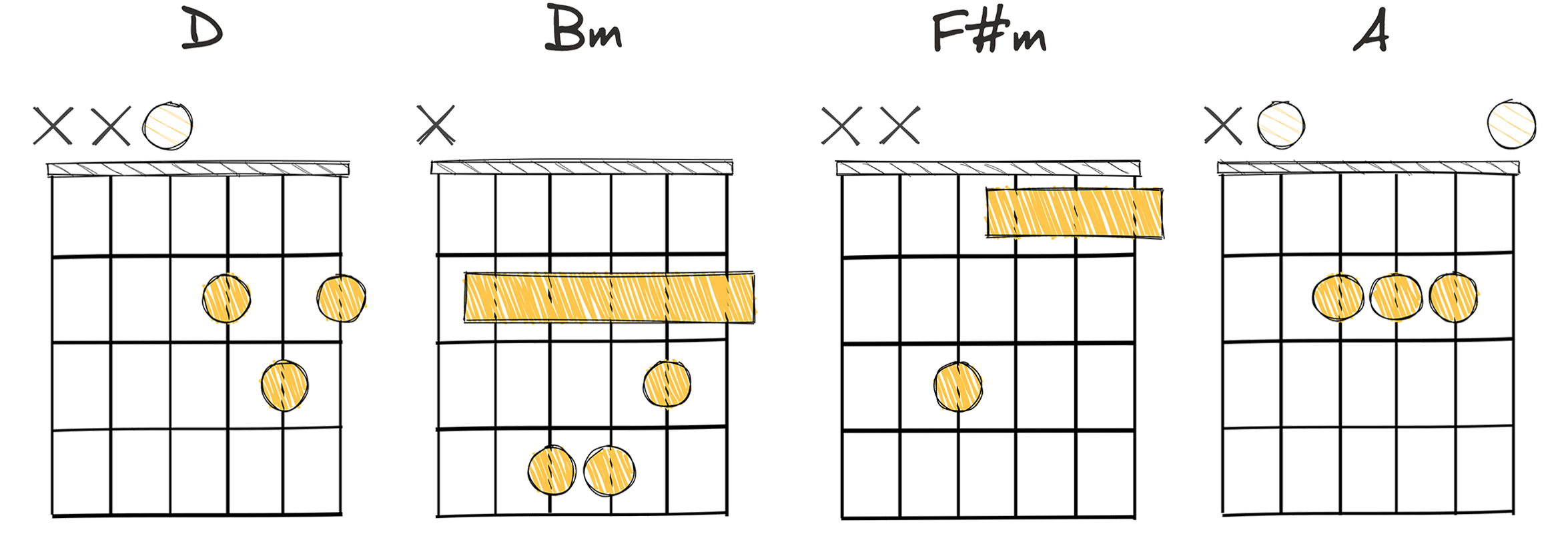
The I–vi–iii–V chord progression is a crucial arrangement that every musician, irrespective of their level of expertise needs to master.
This form of arrangement has not only stood the test of time but has also proven its worth across various genres of music over the years.
Originating from jazz music, the I–vi–iii–V chord progression quickly gained popularity in other music genres, including pop and rock music.
In support of this history claim, the chord progression is often found in many hit sons and is sometimes referred to as the ’50s progression’ since it was quite popular during that era.
Also, this progression creates a flowing movement of chords that provide both harmonious and melodic richness to any song.
The I–vi–iii–V chord progression encourages a sense of anticipation and resolution, making it a potent tool for songwriters in creating emotionally engaging songs.
Last but not least, as a musician or songwriter, the knowledge and understanding of the I–vi–iii–V chord progression can open up a world of possibilities for your compositions.
Its versatility, simplicity, and emotional depth make it an essential tool in every musician’s toolkit.
I-III-IV-V (1-3-4-5)
Uplifting progression popular for creating anticipation in pop music.
This particular chord progression, I-III-IV-V, is a fundamental arrangement in music representing the first, third, fourth, and fifth notes of a major scale that creates a harmonious melody when played in sequence. It’s a staple in numerous genres of music for its charming simplicity yet potent melodic effect, offering an essential and versatile tool for every musician’s repertoire to build a variety of melodies or composing songs.
- Difficulty: Easy
- Example: G – B – C – D (Key of G major)
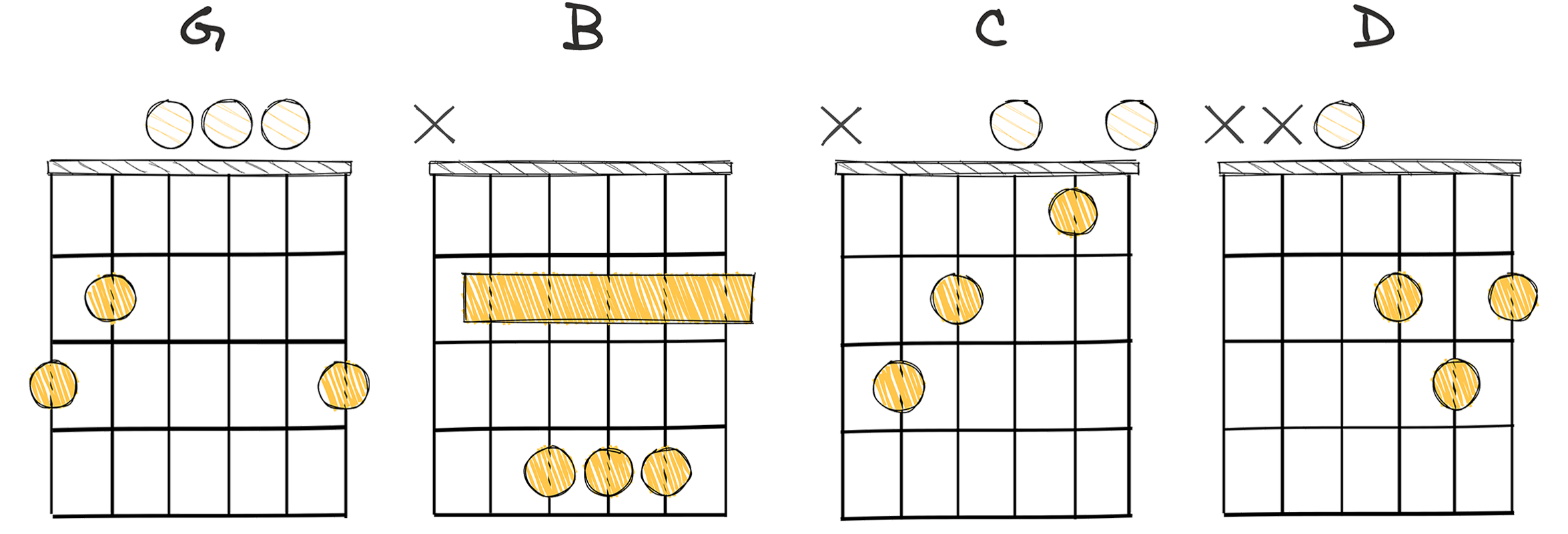
In the vast array of musical expression, one progression notably stands out due to its simple yet profound beauty, the I-III-IV-V chord progression.
Often referred to as the 1-3-4-5 in numerical notation, this pattern holds a distinguished place in the echelons of key chord progressions.
The history of the I-III-IV-V progression stretches back to the roots of Western music.
Its origins are nestled amongst the musical works of the classical era, later finding its way into modern genres such as pop, rock, and blues.
It’s worth noting that the I-III-IV-V progression is relatively easy to play, which makes it a popular choice for many musicians, regardless of their skill level.
This is partly due to the comfortable finger placement on most instruments which enables seamless transition between chords.
The I-III-IV-V progression provides a strong melodic base, revealing an underlying structure that is pleasant to the ear.
It invokes a sense of harmony and balance, leading to a resolution that is both satisfying and intriguing at the same time.
This I-III-IV-V progression in G major has been utilized in numerous songs across various genres, proving it to be a versatile chord progression.
Undeniably, it embodies a universal appeal that resonates with listeners, invoking strong emotional responses.
The chord progression’s structure encourages creativity, allowing for unique innovations whilst still adhering to its fundamental musical framework.
Using different rhythmic patterns, instrumentation or even inversions can greatly diversify how the progression is perceived, revealing its rich potential.
Indeed, the I-III-IV-V progression bears importance not only due to its historical prevalence but also due to its capability to express the musical vision of the composer.
It encapsulates an array of emotions and dynamics, making it a cornerstone of major chord progressions.
Creatively experimenting with the I-III-IV-V chord progression can open new avenues for musical exploration.
As it caters to both beginners and experienced musicians alike, it is a chord progression that is a mainstay in the repertoire of any musician.
The I-III-IV-V progression is far more than just a simple combination of chords.
It is a testament to the power of harmony in music and the magic that can be conjured with seemingly simple tools.
I–IV–V–vi (1–4–5–6)
This progression showcases foundational pivot points for dynamic tension release.
The I–IV–V–vi progression, often used in pop and rock music, commences from the subdominant, resolves to the tonic, then moves to the dominant before concluding on the submediant. Its beautiful, catchy and introspective melody makes it an essential progression for every musician to master, providing a great foundation for songwriting.
- Difficulty: Easy
- Example: G – C – D – Em (Key of G major)
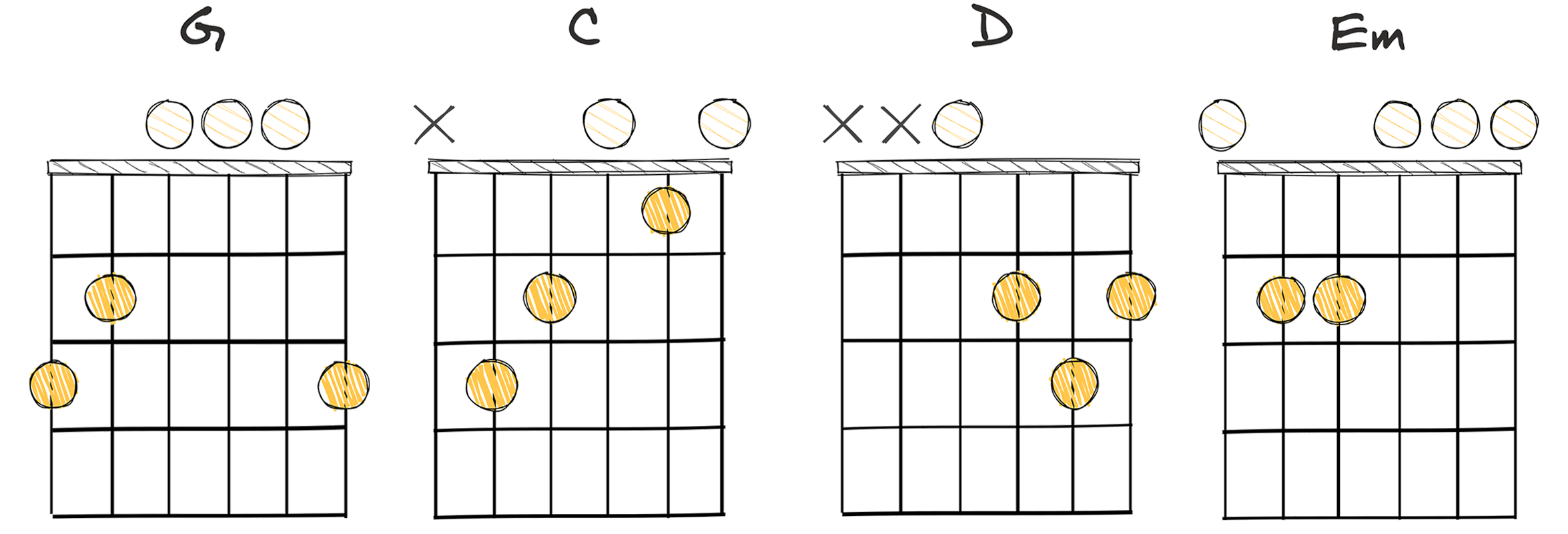
Taking a closer look at the sixteenth section of our list of essential major chord progressions, we encounter the I–IV–V–vi progression.
Historically, the I–IV–V–vi chord progression has found significant usage in a wide array of music genres.
It’s a cornerstone of western music, easily identifiable in songs across classical, jazz, pop, and rock genres.
The I–IV–V–vi progression is easy to play, giving it appeal for beginners and professional musicians alike.
Its simplicity makes it a popular choice for those just starting with their musical journey.
Striking the perfect balance between accessibility and richness of sound, this chord progression serves as a foundational building block for many melodies and harmonies.
While the progression may come across as basic to some, the complexity it can muster is directly proportional to the musician’s creativity and understanding of music theory.
Simply put, the I–IV–V–vi progression’s ability to capture a wide emotional spectrum within its framework, while still being accessible, makes it a perfect tool for musicians to weave compelling soundscapes.
Mastering the IV-I-V-VI progression isn’t just necessary for the well-rounded musician—it’s essential.
To truly understand its significance, one has to understand its history, observe its usage in music, and practice playing it.
Playing this progression using the G – C – D – Em chords might seem simple, but the melodic potential it holds is limitless.
What matters at the end of the day is how you, as a musician, interpret and express it in your own unique style.
I-II-IV-V (1-2-4-5)
Guitarists’ favorite, this progression creates a unique uplifting musical journey.
The I-II-IV-V chord progression is profound in its simplicity and versatility in many genres of music, particularly in pop and rock. This sequence often creates a uplifting tonal landscape, beginning with a resolved, home-base chord (I), before moving onto a more unresolved, tense sound (II & IV) and ultimatily arriving back at a strong, resolved dominant chord (V).
- Difficulty: Easy
- Example: D – E – G – A (Key of D major)
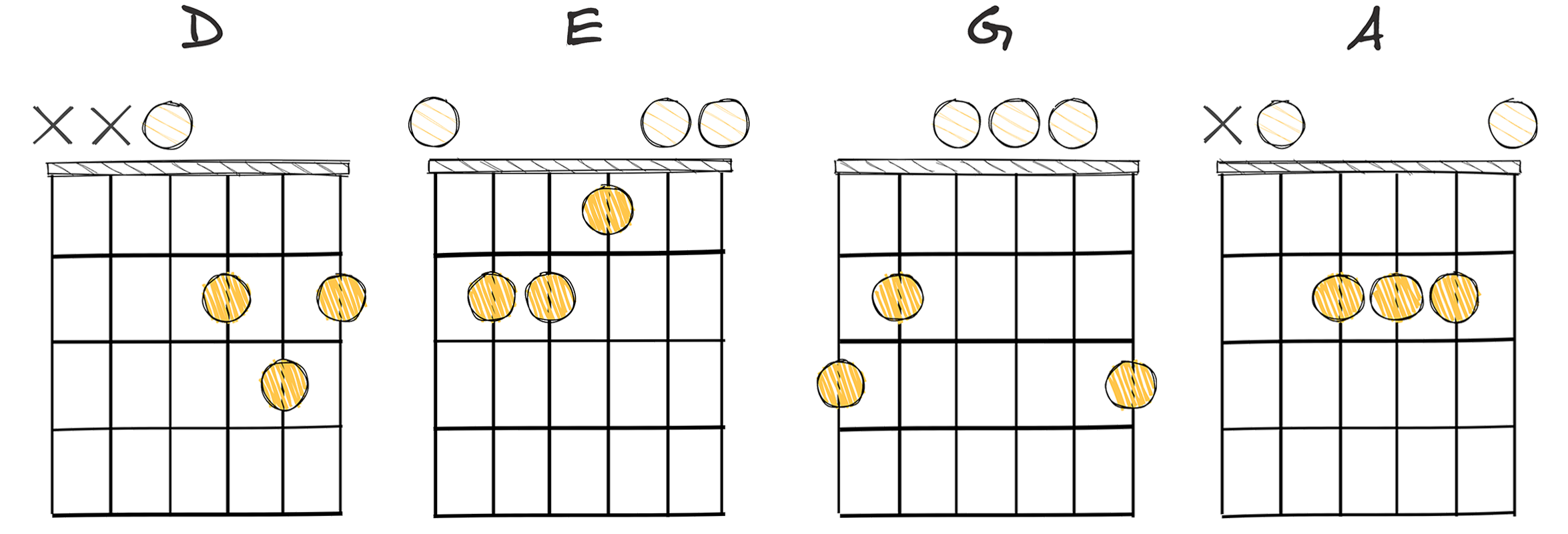
The I-II-IV-V (1-2-4-5) chord progression is a classic progression that features prominently in numerous genres of music.
From rock and pop to country and jazz, this beloved arrangement enhances the songs’ varying moods, making it a favorite among musicians and listeners alike.
This chord progression, sometimes known as the 50s progression, features the first, second, fourth, and fifth degrees of the major scale, creating a harmonious sequence that conveys a range of emotions.
It is often heard in a 4/4 time signature, although it can certainly be adapted to meet the requirements of a variety of musical styles.
The I-II-IV-V progression has a rich history, stretching as far back as the classical music period and continuing through modern times.
From Beethoven to the Beatles, countless composers and songwriters have relied on its appealing simplicity to craft unforgettable melodies.
Part of its appeal is that the I-II-IV-V progression is easy to play.
This progression, with its logical structure and pleasing resolution, effortless transitions that lead beginners to gain confidence easily.
D – E – G – A (Key of D major) is an example of the I-II-IV-V progression that is regularly applied in music
The chords D, E, G, and A are used in order in the 1-2-4-5 sequence, and each contributes a distinctive tone to the overall progression.
The D is the tonic, or the ‘home’ chord, the E adds a touch of dissonance as the second degree, and the G and A chords offer a fulfilling resolution.
The G chord’s presence as the fourth degree adds a touch of subdominant tones, contributing to the song’s overall mood and emotional resonance.
It provides a perfect setup for the A chord, which, as the fifth degree, is considered the dominant and offers the resolution that listeners instinctively crave in music.
Together, these four chords create an irresistible sense of movement, carrying the listener along through the song’s changes in tone and mood.
Due to this, the I-II-IV-V progression is often associated with positive, upbeat songs that make it a staple at celebrations and gatherings.
It is crucial to know that although the I-II-IV-V progression is used commonly, it always has room for creativity and personalization.
Whether through chord inversions, melody additions, or rhythmic variations, you can take these four simple chords and make them unmistakably yours.
This versatility is another reason why the I-II-IV-V progression is so popular – it’s a powerhouse musical tool that has continued to inspire new songs, even after centuries of use.
Overall, the I-II-IV-V progression plays a significant role in music history and continues to be a fundamental pillar in music creation today.
It inspires musicians of all levels and backgrounds, making it an essential chord progression that every musician should master.
The Bottom Line
After an exhaustive examination of these harmonic progressions, it is evident that they form the backbone of countless songs and compositions across musical genres.
As fundamental as the alphabet to the English language, these chord sequences govern the musical language.
They each have unique characteristics, qualities and emotional resonances, bringing variety and depth to music.
Understanding these foundational chord sequences not only allows the listener to appreciate the complexity and beauty of music but gives musicians and composers the tools to create rich and appealing music.
Whether intentionally employed or intrinsically absorbed, these progressions elucidate the universal language of musical composition.
In love with guitars, and gear; expert in all things music! Been writing about guitars for about 5 years and counting. Born in the ’90s. Alma Mater: University of Havana. Always curious, trying to understand the world. #TeamFender




